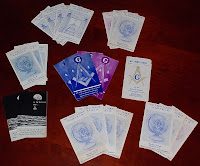 An assortment of lodge trestleboards dominates this box. Dated from January 1968 to March 1976, there are 31 in all. Unlike the typical trestleboard seen in New Jersey today, which is a tri-fold sheet of letter-size paper, these are small (6 x 3 ½ inch) two-color, six-page booklets, seemingly tailored to fit in the shirt pocket.
An assortment of lodge trestleboards dominates this box. Dated from January 1968 to March 1976, there are 31 in all. Unlike the typical trestleboard seen in New Jersey today, which is a tri-fold sheet of letter-size paper, these are small (6 x 3 ½ inch) two-color, six-page booklets, seemingly tailored to fit in the shirt pocket.Their contents are unremarkable. I had hoped for Lux ex Oriente, or even Lux ex Cathedra, but it seems Mt. Nebo was a lodge that emphasized sociability over exploring the great mysteries and philosophies of life. Makes me wonder if maybe that is partially why the lodge and its 10 neighbors are all gone. Mt. Nebo Lodge was chartered on April 24, 1924 – the same day that my original lodge was chartered as No. 249, something serendipitous that I didn’t realize at the time of my initiation 30 years after my grandfather was made a Mason.
On Wednesday, March 20, 1968, the brethren in the Level Club met at Townleys’ restaurant at 6:15 for dinner, and left an hour later to catch the Knick game at the Garden. (The visiting team was the Cincinnati Royals, yet another defunct entity.) The ’68 Knicks of course was the team of Dick Barnett, Bill Bradley, Dave DeBusschere, Walt Frazier, Willis Reed… the Hall of Famers who had their numbers retired. But get this: The brethren left Elizabeth, New Jersey at 7:15 p.m. for a game at Madison Square Garden. If you tried that today, you’d miss the game.
Total assets on Dec. 31, 1967: $25,631 (that’s $168,596 in today’s money). 1968 dues: $17.50, including the $1 Grand Lodge assessment. Junior Past Master Albert M. Pines was feted February 18 at Short Hills Caterers ($11.50 per person). 44th Anniversary Dinner-Dance at Richfield Regency Caterers on May 22. Met game on June 19. Picnic September 15 in Warinanco Park. The lodge’s major accomplishment of 1968 was its establishment of a blood bank. Sid served as Chaplain that year, his first full year in Masonry.
 A booklet even smaller than the trestleboard was the lodge membership roster, like this one from 1962. Junior Warden Stan Glasser is still around; I chatted with him at a recent meeting of our Consistory. (New Jersey Consistory is the oldest Scottish Rite Consistory in New Jersey, chartered in 1867. It met in Newark when Stan and my grandfather joined, then was moved to Livingston in 1972, then to Lincoln Park in 1977, and this month it relocates yet again, this time to Union.)
A booklet even smaller than the trestleboard was the lodge membership roster, like this one from 1962. Junior Warden Stan Glasser is still around; I chatted with him at a recent meeting of our Consistory. (New Jersey Consistory is the oldest Scottish Rite Consistory in New Jersey, chartered in 1867. It met in Newark when Stan and my grandfather joined, then was moved to Livingston in 1972, then to Lincoln Park in 1977, and this month it relocates yet again, this time to Union.)There were a few non-Masonic papers and objects inside the Bances box that stand out. The sterling silver kiddish cup is out of place. The Morgan silver dollar (1884, New Orleans) is an entirely typical, predictable item to find among personal effects in my family...
 ... but the handgun permit and sales receipt for a Colt .38 Special are not. The late ’60s was a violent time. Acres of Newark remain vacant today, 43 years after the riots of the summer of 1967. That was my family’s hometown, and while they had moved out before Newark began its rapid decay, they still resided and worked not too far away. The sales receipt for this revolver is dated April 4, 1968, coincidentally the day Martin Luther King was murdered, which precipitated more rioting.
... but the handgun permit and sales receipt for a Colt .38 Special are not. The late ’60s was a violent time. Acres of Newark remain vacant today, 43 years after the riots of the summer of 1967. That was my family’s hometown, and while they had moved out before Newark began its rapid decay, they still resided and worked not too far away. The sales receipt for this revolver is dated April 4, 1968, coincidentally the day Martin Luther King was murdered, which precipitated more rioting.But the Masonic journey of the late W. Sid begins with this letter from W. Joseph Bernstein, Secretary of Mt. Nebo Lodge No. 248. Dated January 24, 1967, it informs its happy recipient that his EA° would be Monday, February 13, and that the $200 balance of his initiation fee will be accepted that night. That $200 is in addition to whatever deposit accompanied the petition for membership. If the complete initiaton fee totaled $250, that would equal $1,644 in today’s money. Has your lodge kept up with inflation?
Perhaps more mementos will be found in the house. My grandfather smoked a brand of Havanas called Gold Label. I remain hopeful that a Past Master’s jewel has yet to be discovered in one of those boxes.








































































































